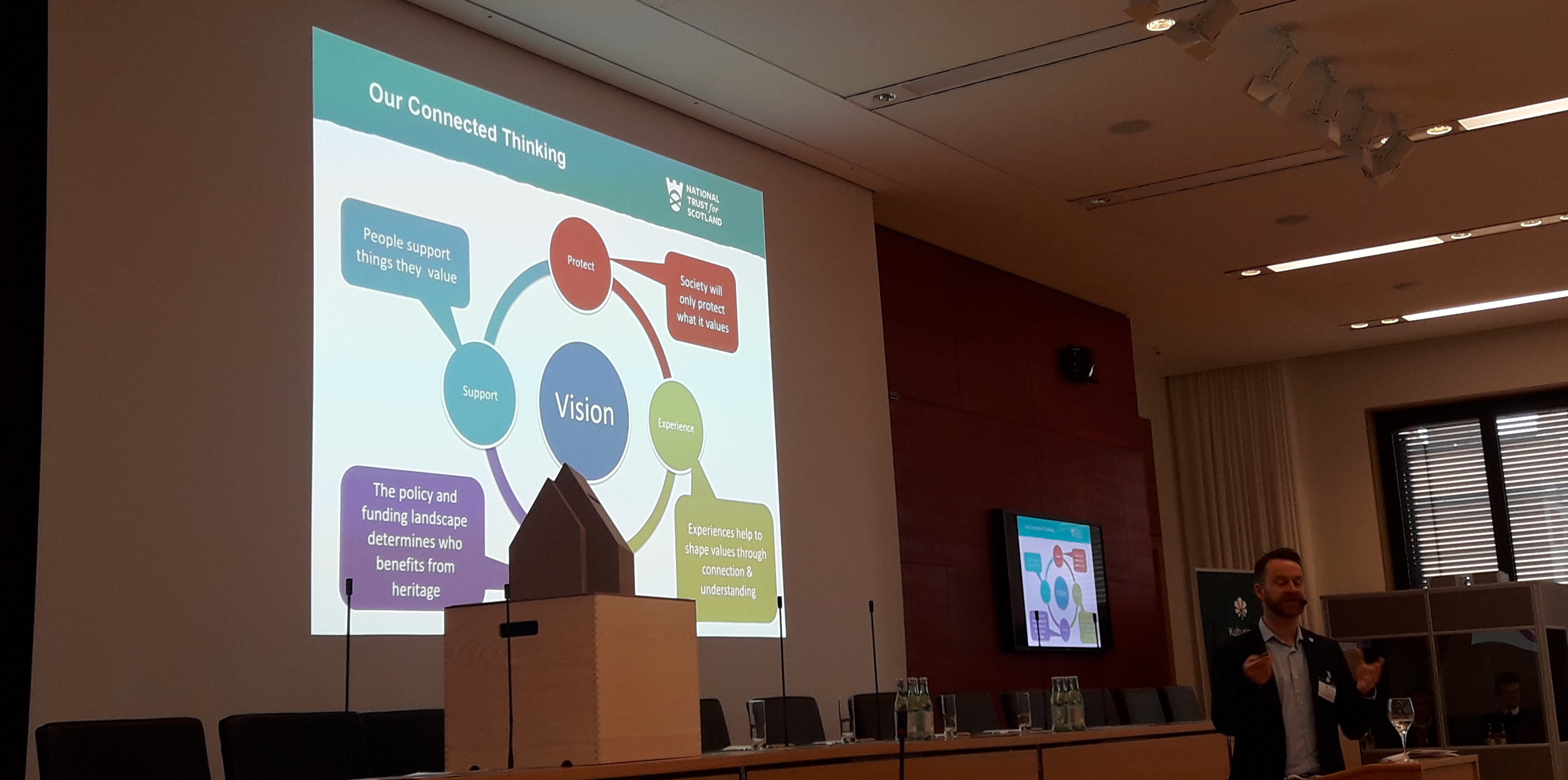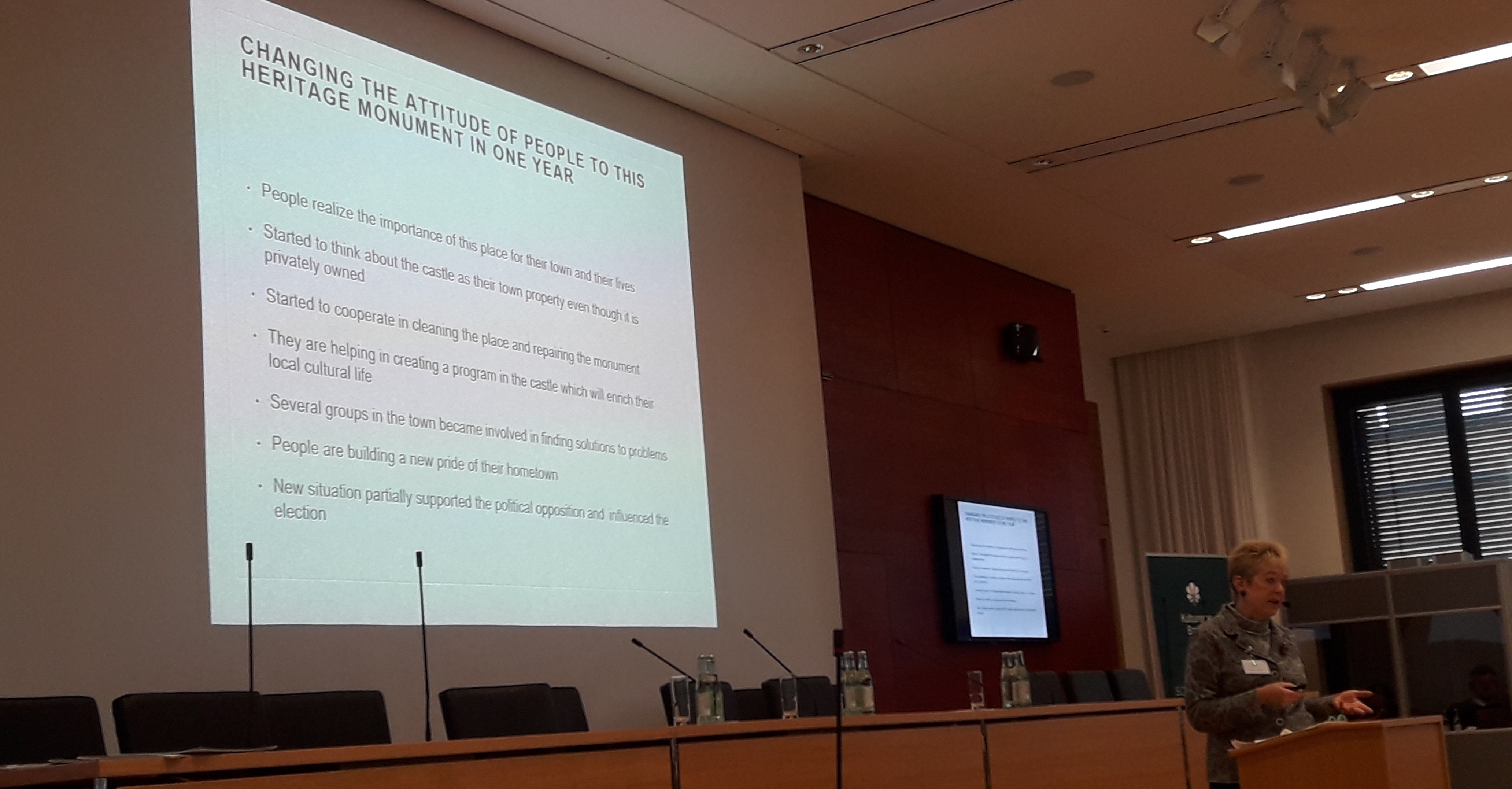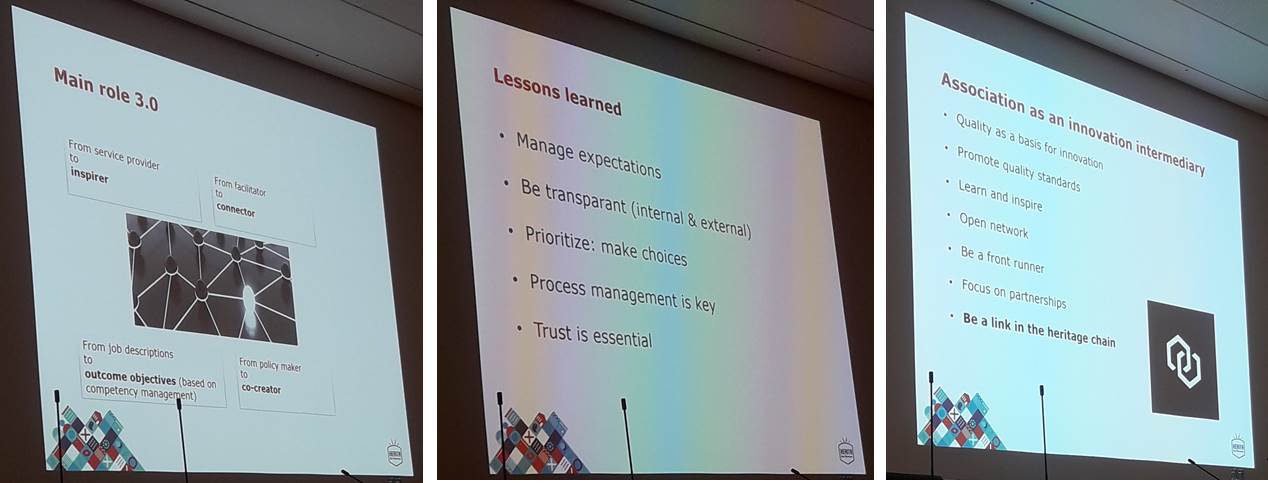-
Kulturerbe Bayern: New kid on the block (Weekly blog, 25 November 2018)
Posted on November 25, 2018A blog by Catherine Leonard, Secretary-General
Kulturerbe Bayern is the Bavarian National Trust and it was established around three years ago. This week, I went to Munich to celebrate the launch of their new Foundation. The events included the ‘Sharing Heritage’ symposium at the Bavarian Parliament (below), which involved several INTO members and friends.

Sharing Heritage
The Chairman of the Foundation Board, former President of the Bavarian Parliament Johann Böhm opened the symposium. He explained how Kulturerbe Bayern has grown from seventeen members to now over seven hundred, supported by 170 volunteers. Moreover it has its first property! A 15th century house in Rothenburg ob der Tauber. However, perhaps most interesting was firstly what he said about international collaboration and our common European inheritance. Secondly, that their focus was not on preserving the past but about people today. (Something I underlined in my speech!)
Professor Mathias Pfeil of the Bavarian State Heritage Office spoke about the role cultural heritage plays in identity. Also the importance of community support and particularly how urban buildings can be reused as shops or old people’s homes.
Messages from the INTO family
My speech was fundamentally a welcome to the global family of National Trusts and some thoughts for the future. I had asked the INTO community for words of advice for Kulturerbe Bayern, as a fairly new National Trust. Here are some of things they said:
“Seek, value, use and recognise the enthusiasm, time and energies of your volunteers because they are your best ambassadors and in many ways your most valuable contributors.”
“Never forget that members, supporters and staff are the life blood of the organisation and to always hold true to your raison d’etre, ideals and aspirations, even in the face of opposition”
“My only suggestion to the new organisation is that in all the activities, they must ensure community involvement. That is the key to success”
“Enthusiasm is contagious!”
I used these good wishes to highlight the importance of people to all our work, why heritage matters and what we can do to forge stronger and more inclusive connections between places and people. (Presentation slides can be found here.)
German sister organisations
There were several presentations from Germany organisations, some of which would make excellent INTO members!
The first was from Deutsche Stiftung Denkmalschutz. This is a foundation which raises funds from private sources for heritage projects across the whole of Germany. If I heard correctly it gives grants of around €22m every year, which is pretty impressive. Whilst it doesn’t own any sites it is very active in education, through its Denkmal Aktiv programme, and volunteering. It also cooperates with Rempart on working holidays. Lastly, like Herita and the NTEWNI, DSD runs Heritage Open Days in Germany.
The second was the NRW Foundation in North Rhine-Westfalia. This organisation gives grants to associations and ngos across its three main themes: Nature, homeland and culture. It also owns 6,000 hectares of nature reserves and 19 monuments. One of these is Schloss Drachenburg, situated on the Drachenfels above the river Rhine near Bonn. And where, legend has it, Siegfried famously slaughtered the dragon. It too took inspiration from the National Trust when it was established in 1986.
Obviously there were also lots of presentations about Kulturerbe Bayern, what it’s achieved so far and its plans for the future.
I have to say that I was hugely impressed and am very confident that it will achieve its goals.
Bright future
Firstly, Kulturerbe Bayern has a clear picture of where it is heading. It wants to work with people to preserve and breathe life into heritage treasures for future generations. People with a technical interest in old buildings; people who feel the pull of ‘heimat’ or homeland and people who love local culture. And bringing them together as volunteers, members and donors as part of Kulturerbe Bayern. ‘Schönheit’ or beauty and quality of life are also key values.

Secondly, Kulturerbe Bayern has already secured some really smart, generous and hardworking advocates and supporters. We met many of these who are very actively involved in both running the organisation and its first property (above).
And it is Judengasse number 10 which is the third great strength. Andreas Hänel, a member of the Foundation Board, explained the selection process and criteria. This house was chosen for its manageable size and interesting history (it has a traditional Jewish mikvah bath in the cellar). Moreover it is a building that can be used in different ways and it already has a strong connection to a local association.
Lastly, Kulturerbe Bayern is a highly professional looking organisation. This came across loud and clear at the public event on Saturday evening. Nice logo (a chestnut leaf), slick presentation, great images, heart-warming videos. They have engaged a number of famous people as ‘ambassadors’ and, well, it’s just a really cool organisation to be associated with.

Stories from European neighbours
What was particularly nice about the symposium was that it brought together other INTO members. The National Trust for Scotland, Czech National Trust, Gelderland Trust and Herita.
Bryan Dickson, Head of Buildings Conservation Policy, introduced the National Trust for Scotland. It was really good to be reminded of the similarities and differences between the NTS and NTEWNI. Much felt very familiar. Particularly the connected thinking wheel. (Look after what we’ve got – society will only protect what it values; New experiences help to shape values through connection and understanding; Advocate for heritage – the policy and funding landscape determines who benefits from heritage; People support things they value.)

Likewise, the NTS’s values of caring; curious; inclusive; brave and vibrant. And the priority to provide more opportunity for people to engage with their heritage, ‘valued by everyone’.
The Little Houses Improvement Scheme which has saved 210 houses in 62 communities is also a good model for INTO members.
Everyone was very taken by the presentation from Eva Heyd, Director of the Czech National Trust. She spoke about Rožmitál Castle and how community attitudes have changed since the CNT began tidying it up. People better understand its importance to the town, they feel it’s ‘theirs’ and have started helping with cleaning and repairs. (You too can feel the power of Rožmitál by doing an INTO working holiday there next year!)

The approach of the Swiss organisation, Ferien im Baudenkmal, is also interesting. They gently renovate and then rent out rural cottages to tourists, thereby revitalising whole villages.
The Gelderland Trust has been a member of INTO from the very start and I thought needed no introduction. And yet! It was fascinating to hear from Jeanine Perryck about the history of the organisation. It shares many roots with the National Trust in that its founders were concerned about people in cities losing touch with nature. Also, the Netherlands suffered the same economic conditions which meant aristocrats were unable to maintain their homes. The Trust was established in order to keep their estates intact.
The Gelderland Trust has now evolved from protest and preservation to inspiration! And the figures are also impressive. It looks after 120 nature reserves, 35 castles and historic houses (of which 7 are open to the public), 25,000 objects, 136 employees, 45,267 contributors, 233,000 visitors, a turnover of €17m (of which 85% own income) and generates €2-3m a year in legacies.
Margit Bal introduced Herita, which I wrote about in another blog very recently. This time my takeaways were slightly different. The desire of Herita (like the Gelderland Trust) to become completely self-sustaining is very strong. As is their wish to ‘make Heritage Open Days out of every day’.
Margit spoke about their strategy 3.0 and I think the planned step changes are valuable to all our members.

The last international speaker was INTO friend, Graham Bell of the North of England Civic Trust. Graham left us all thinking about the three words in the name ‘National Trust (of) Bavaria’ and considering our shared values and aspirations. He also introduced several of the networks he is in involved in, including Europa Nostra.
In love with Bavaria
All in all, it was an incredible few days. It was wonderful to see how far Kulturerbe Bayern has come over the past three years. Equally to reconnect with the MP with whom I discussed the possibility of a Bavarian National Trust back in 2014. There is a little more about that meeting with Robert Brannekämper in an earlier blog.

But for me, the best thing about the whole experience has been rediscovering Bavaria. I spent six months at university in Passau during my studies. However, I have barely been back to Germany since I graduated. And I have forgotten most of my German. This trip to Munich has reminded me how much I love Bavaria! I actually tracked down my school penfriend and whilst we weren’t able to meet on this trip, I really hope we will sometime. I drank beer in the Hofbräukeller, I had Brotzeit, and I ate Knödel, Schnitzel and a Berliner! I tapped my foot to funky, Bavarian folk music. I reveled in the images of Bavarian villages and countryside we were shown. (Where are my hiking boots?!) I even dug up some sentences of German, locked away in a cabinet at the back of my mind! I’m so grateful to have been invited to be part of the Kulturerbe Bayern story and look forward to future collaborations.
Thanks for reading!

 44 (0)20 7824 7157
44 (0)20 7824 7157